April 15, 2025
How to Automate Content Creation and Boost Productivity
The key to staying relevant in today’s fast-paced and competitive digital world is consistently delivering high-quality, engaging, and valuable content to your audience. However, the content creation process can be tedious, time-consuming, and resource-intensive.
The question that comes readily to mind is: how can you efficiently produce high-quality content that is customer-centric?
Content automation is the solution. Whether you are a business owner or content creator, you need AI-driven solutions to streamline content creation, enhance efficiency, maintain consistency, and boost productivity. These artificial intelligence and automation tools help handle repetitive and time-consuming tasks while you focus on more complex, strategic, and high-value initiatives.
Let’s explore content automation in detail: the meaning, content automation examples, content automation tools, and how to successfully automate content creation.
Meaning of Content Automation
Content automation is the use of advanced technology, such as artificial intelligence and machine learning, to create, manage, distribute, and optimize the content creation process with minimal human intervention.
These technologies help to automate content creation tasks, allowing human professionals to focus on more strategic responsibilities. Large volumes of content can be simultaneously and efficiently managed, thereby reducing response times and ensuring consistent production of high-quality content.
Businesses that automate content creation can scale their content creation without compromising accuracy, branding, and engagement.
Content automation can streamline the various stages of the content creation process, such as:
- Idea generation
- Content writing and distribution
- Content scheduling
- Content management and optimization
- Editing and proofreading
- Performance analysis
Type of Content You Can Automate
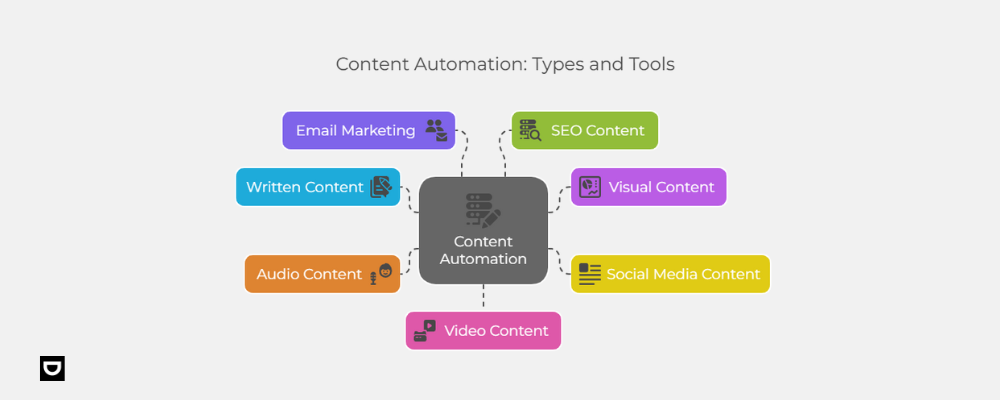
The essence of content automation is simply to automate the content creation process. You can leverage these automation tools to perform the following tasks:
- Written content: Articles, blog posts, and product descriptions
- Visual content: Infographics, charts and image editing
- Social media content: Social media posts, captions, scheduling and updates
- Audio content: Podcast intros/outros, text-to-speech conversion, basic voice-overs
- Email marketing campaigns: Personalize and schedule email sequences
- SEO content: keyword research, optimization, meta descriptions and content structuring
- Video content: Short-form videos, animated explainers, and video captions
How to Effectively Implement Content Automation

Automated content creation can help with the numerous aspects of content creation. It automates content ideation, planning, writing, editing, scheduling, distribution, optimization, and management. To ensure the successful implementation of automated content creation, here is a comprehensive guide for you.
1. Clearly Define Your Goals
Before beginning the content automation process, it is crucial to thoroughly evaluate your content needs and goals.
As a business owner, marketer, or content creator, clearly define your content marketing objectives. Do you want to increase sales, generate leads, or enhance engagement? Identify your specific goal and define it, while ensuring the goal aligns with your overall business strategy.
2. Understand Your Target Audience
Once you’ve defined your specific need or goal, you need to develop detailed buyer personas to understand and capture your target audience’s pain points, interests, and preferences. Use analytics and insights to determine who your audience is, their interests, and how they engage with your content. This information will guide you in your content strategy and ensure that your automated efforts are targeted and effective.
Understanding your target audience is pivotal to successfully implementing content automation. The knowledge of your audience will help you better tailor content that resonates with them.
3. Develop a Content Strategy
Establish a comprehensive content strategy that outlines the type of content you plan to create. It could be video content, social media content, audio content, written content, and so on. The type of content highlighted in this article can be a guide on what type of content to develop.
The content strategy should also outline the theme and topics, the target audience, the channels for distribution, and the desired outcomes. Determine the frequency of publication and how it will be distributed for each channel. Additionally, draft a content calendar to carefully plan and organize your automated content efforts.
A well-structured content strategy will guide your content automation strategy and act as a roadmap for content automation tools.
4. Choose the Right Content Automation Tools
Selecting the right tools is crucial to successfully implementing your automated content creation process. Conduct thorough research and evaluate the different available content automation tools based on your specific content needs, ease of integration and use, budget, and scalability. Consider personalization options and their ability to integrate with other tools and platforms.
Ensure to choose tools that have important features, including content ideation, SEO enhancements, omnichannel integration, and performance analytics. Test multiple tools through free trials and demos before incorporating them in your business to determine their efficiency and whether they can produce the desired result.
Dumpling.ai is a powerful tool for automating your content creation process. It offers a wide range of features to streamline content creation and boost productivity.
5. Create Content Templates
Content templates and guidelines are important precursors to successful content automation. These content templates serve as a foundation on which the automated can construct content.
Create different templates for different content types and guidelines that outline your brand’s tone, voice, and writing styles to maintain consistency across all channels or platforms. The style guides for formatting, image usage, and other visual elements should be included. Then, ensure the templates and guidelines are easily accessible by your teams and can be integrated into your automation tools.
6. Train Your Team
While automation streamlines content production, human oversight is essential to maintain brand voice, accuracy, and engagement. Training helps employees understand how automation tools fit into their existing content creation process, thereby ensuring seamless integration with workflow. A well-trained employee can avoid common pitfalls such as over-reliance on automation, generic content output, or AI-generated inaccuracies.
Ensure your team is well-trained in using content automation tools, provide support to help them adapt to the new processes and make the most of the technology. Encourage a culture of continuous learning and adaptation as automation technologies evolve.
7. Prioritize Personalization
In the implementation phase, ensure your content automation efforts prioritize personalization and relevance for your target audience. Use AI-powered technologies to analyze user preferences, pain points, interests, and behavior to deliver personalized content for better engagement.
8. Maintain Quality Control
The authenticity and quality of your content are essential in building trust with your audience. When content is automated, implement quality control measures to make it feel authentic.
Regularly review and edit your content to ensure the quality of the output. Make sure the automated content aligns with your consistency and accuracy. Establish a review process that requires human input to check and verify automated content for accuracy, tone, and alignment with brand guidelines.
9. Monitor Performance and Optimize
Content automation is more than just setting it. You do not just leave your automated content to daily handle your content operations. You have to constantly monitor the performance, analyze, and optimize the content.
Regularly monitor the performance of your automated content. Analyze key performance indicators (KPIs) and adapt your content strategy and tools as needed to achieve desired outcomes. Additionally, use SEO performance to optimize content automation strategies over time.
10. Continuously Iterate and Improve
Content automation is a continuous process that requires continuous improvement. Regularly review your automated content, gather feedback from your team, and update it to reflect new information and trends.
This process makes your content stay relevant and valuable to your audience.
Real-Life Examples of Content Automation in Action
In today’s tech-driven landscape, businesses and individuals use content automation for their content creation process. Some of the content automation examples are:
- E-Commerce Product Descriptions: Large and popular retailers like Amazon and eBay use content automation tools to generate unique product descriptions at scale without manual intervention while maintaining accuracy and consistency.
- Social Media Scheduling: Brands like Nike and Coca-Cola use AI-based solutions to automate social media posts across multiple platforms.
- Email Marketing Automation: Netflix uses content automation to personalize email sequences and recommend movies and shows based on user history and interactions.
For automating the various aspects of content creation, explore Dumpling AI .
Content Automation Tools and Functions
Content automation tools are AI-powered technologies and solutions used for content creation. Below are some popular content automation tools are:
The Content Automation
Dumpling AI
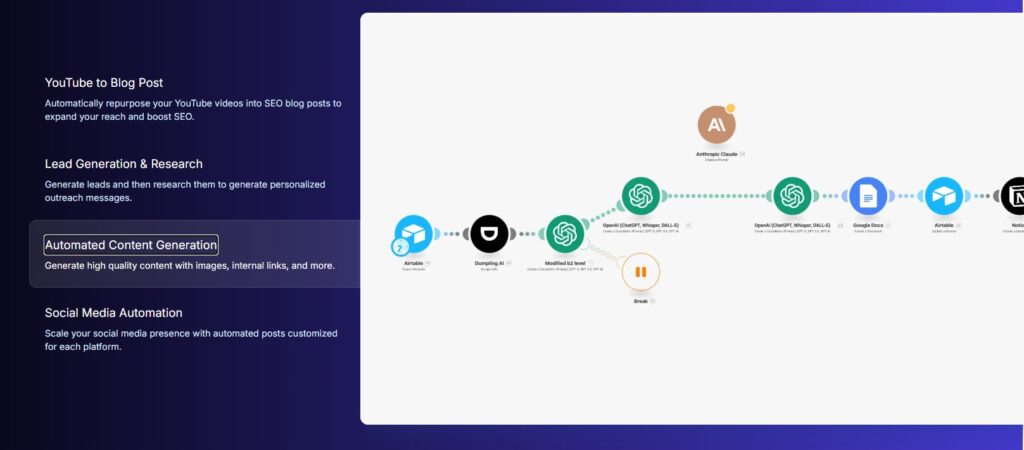
Dumpling.ai is a content creation automation tool designed to streamline and enhance digital content generation. It offers AI tools for generating blog content, rewriting text, summarizing YouTube videos, and creating social media posts.
Features
- AI Paragraph Generator for crafting well-structured content.
- AI Rewriter refines and rephrases text.
- AI Bio, Email, and Post Generators assist in creating professional bios, emails, and social media posts.
Dumpling.ai also integrates with Make.com and Zapier, enabling users to automate content workflows without coding. It is ideal for marketers, bloggers, and businesses looking to improve efficiency and maintain content consistency across platforms. By leveraging Dumpling.ai, users can save time, boost engagement, and ensure high-quality content production with minimal effort.
Keyword Research
Keyword research is the process of identifying relevant terms related to what you do that your target audience enters in search engines. Using the right tools to automate the process will make it easier and faster.
- Google Keyword Planner

Google Keyword Planner is a free tool that allows you to research keywords and see the number of people searching for the words. It also gives information about the competition for each word. It is a tool that gives you the search volume with different keywords to help you create a content strategy.
Features
- It provides keyword search volume
- It is ideal for basic keyword research
- It offers filtering by location and language
2. SEMrush
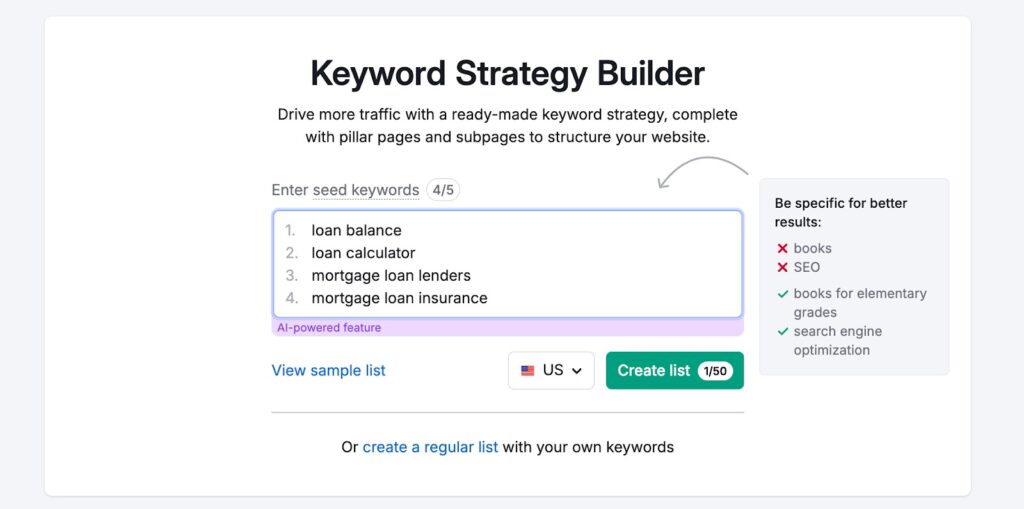
SEMrush is not only a keyword tool that produces a list of keywords but also suggests specific keywords that your competitors are actually using. It offers a wide range of features that help to find and research keywords, such as a keyword search bar and keyword difficulty analysis. SEMrush has a user-friendly interface, which makes it easy to navigate and use.
Features
- It gives yearly keyword trends
- It provides access to the complete keyword research toolkit
- It provides a competitive analysis tools
AI-powered Content Generation
AI-powered content generation is using artificial intelligence to generate written content, images, or videos for different purposes, like ads, blog posts, etc. AI helps in conducting research studies and gathering information to write a blog. It makes work easier and enhances content creation. There are AI tools available that can assist in content creation.
1. ChatGPT

ChatGPT is a tool that helps to write blog posts and social media updates and create articles, essays, and stories, making it faster and easier to create content. It is among the powerful AI language models in existence. It is a go-to tool for businesses and content creators to produce quality written content.
Features
- Impressive Capabilities
- Adaptability and Flexibility
- Language
2. Writesonic

Writesonic is an AI-powered writing assistant that can generate high-converting sales copy and engaging landing page content. It offers various content styles and helps generate top-notch content in less time. It allows users to set the tone of the content according to their choice.
Features
- Human-like conversation
- Produce consistent content.
Content Templates and Management
Content template and management is a guideline that helps content creators plan and create different types of content, such as articles, blog posts, or other written materials. It serves as a blueprint for generating high-quality content by providing a clear structure and key elements.
Content templates can be a valuable tool for writers and content strategists to streamline their content creation process and ensure that their content aligns with their goals and brand messaging.
1. HubSpot Content Management System (CMS)
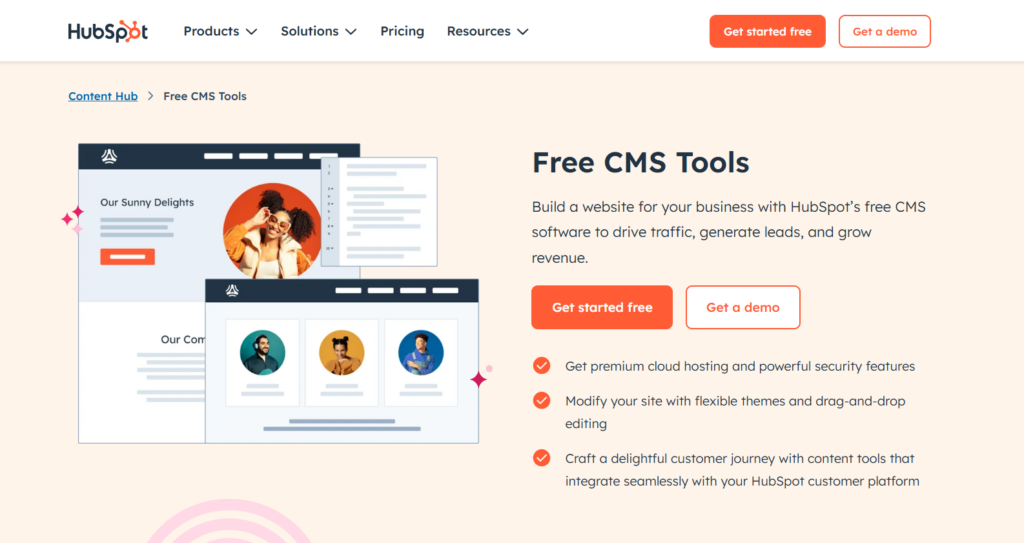
HubSpot content management system (CMS) is a software tool that allows you to create, edit, and publish content on the internet. It organizes website content like articles, posts, images, documents, and media using a central database. Content is usually organized by categories and dates but may also include other data like keyword tags.
Features
- Multi channel publishing
- Content reuse
- Integration with editing tools
2. WordPress

WordPress is a content management system (CMS) that enables users to create, manage, and publish websites and blogs. It provides users with a friendly interface for creating content on their websites.
WordPress also offers a powerful dashboard that allows users to manage their content, track analytics, and monitor their website’s performance. WordPress has the ability to support multiple users, allowing multiple contributors to work on a single website. This makes it an ideal platform for businesses and organizations that need to manage content and collaborate on projects.
Features
- Friendly Interface
- It has open-source software
- Multimedia-friendly
Rewriting and Repurposing Content
Rewriting is about taking existing content and reshaping it to make it clearer, more engaging, and better suited to your audience—without changing its original message.. You get a second version of the existing content while repurposing content is the practice of recycling old content that has performed well and republishing it in a new way. It helps reach a new set of audience who haven’t come into contact with your best-performing content yet.
1. WordAI
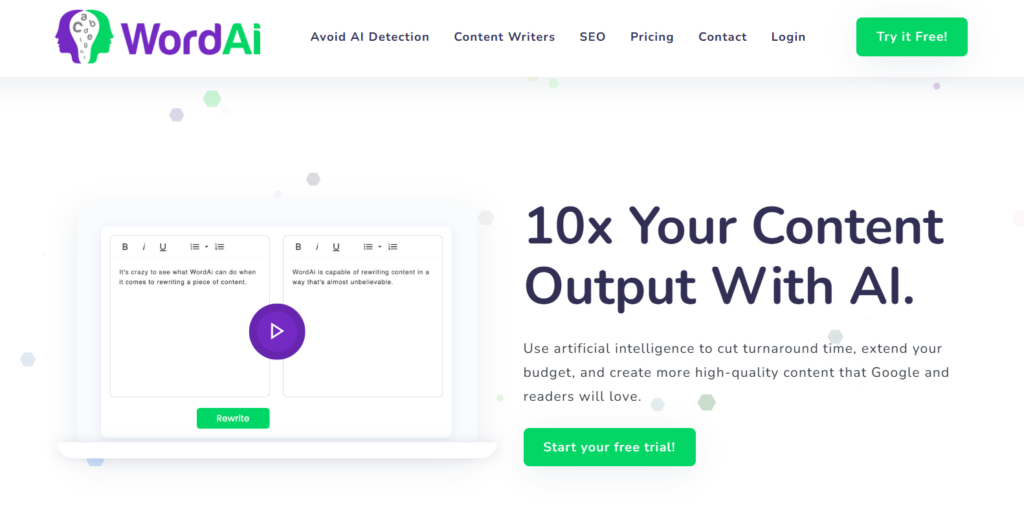
WordAi is an AI-powered content creation and editing tool that can rewrite existing content and generate new content based on existing pieces. It helps to produce new versions of existing content by replacing words, phrases, and sentences with alternative ones.
Features
- It rephrases sentences
- Summarizing
- Creative text format
2. QuillBot
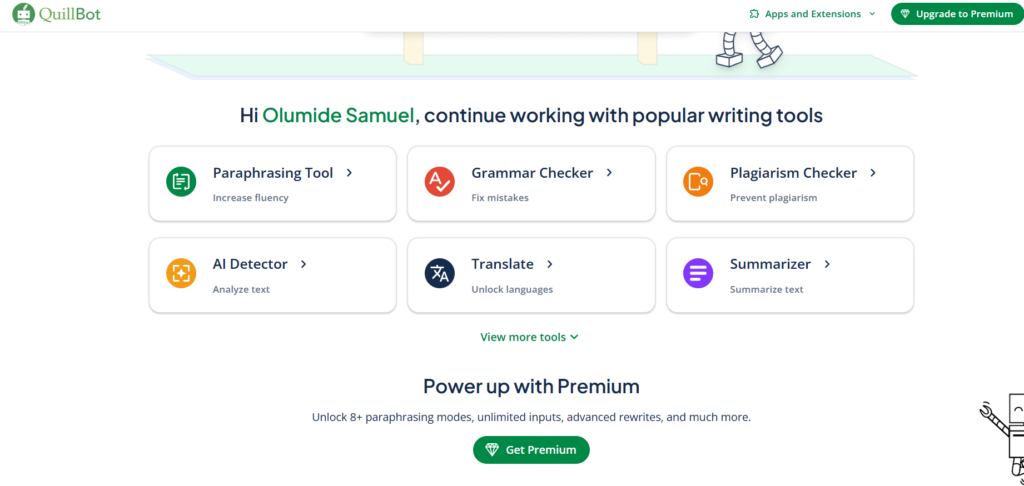
QuillBot is an AI-powered writing assistant tool that helps users to rephrase, summarize, and rewrite their text to improve writing quality and make it more unique. It helps users to rewrite sentences in a way that preserves their meaning while making them more grammatically correct. They can input text and then QuillBot will return a rephrased version of the text.
Features
- Checks and fixes grammar errors
- Translate texts to different languages
- Rephrases content
Content Curation
Content curation involves selecting the best content, such as articles, videos, pictures, or social media posts, to bring it to the attention of others who would be interested.
Content curation tools help you find relevant content. It also makes it easier to share this content through your profile.
Content curation helps to achieve business goals and also generate brand awareness, build trust , drive traffic, and boost sales.
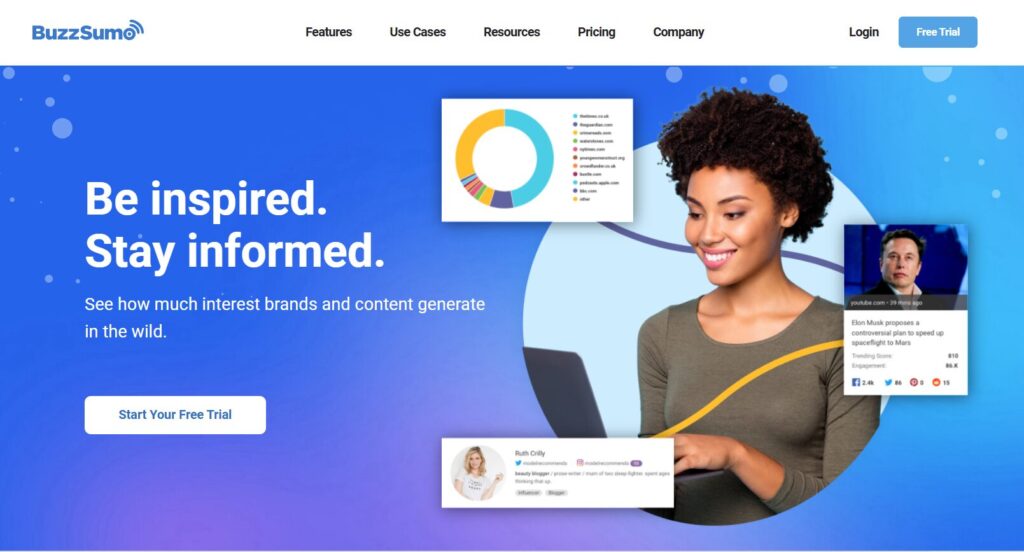
Buzzsumo is a tool designed to help users find out what content is popular by topic. It helps to identify the most engaging and shared content and what works well on social media platforms.
Features
- Content discovery and analysis
- Competitor analysis
- Influencer Research
Picture content automation as your hidden advantage—it helps you save time, maintain consistency, and allows you to zero in on the exciting imaginative aspects.
The Benefits of Content Automation
When you automate your content creation process, there are numerous benefits that come with it. These advantages can significantly influence your business content strategy, productivity, and long-term success. Some of the benefits are:
Increased Efficiency
Content automation technologies help streamline workflow, thereby reducing time, efforts, and resources spent on repetitive tasks. If these tasks are handled manually, they can become time-consuming, prone to errors, and hinder overall productivity, limiting the ability to scale content creation effectively.
For instance, tools like AI writing assistants can generate content like captions, blog posts, and articles in minutes, while automated scheduling platforms ensure your posts go live at optimal times without manual intervention.
As content automation tools handle less complex, tedious, and routine tasks, human agents can concentrate on higher-value responsibilities, such as creative ideation.
Maintain Consistency
Consistency in the content creation process is one of the key benefits of automated content creation. These tools consistently maintain tone, style, and messaging across different channels and platforms, ensuring brand identity is upheld.
Content automation helps ensure that content is generated, distributed, and managed consistently. Automated content calendars and scheduling tools can manage and deploy content at regular intervals, ensuring that your audience always has fresh material to engage with. Errors that would have been committed manually would be prevented, resulting in higher quality content.
Enhanced Creativity
Creativity leads to innovation, which can eventually boost productivity. When content creation is automated, your content team would have adequate time to focus on more complex initiatives that require creativity, strategic thinking, and problem-solving skills.
Content creators will have ample time to brainstorm on the best content strategy and develop ideas that can result in the production of high-quality content that resonates with the target audience.
For example, instead of spending hours on tasks that can easily be done by automation tools, such as formatting blog posts or scheduling social media updates, your team can brainstorm new content series or experiment with different content formats. In this way, your team is empowered to push creative boundaries and produce more engaging, valuable, and high-quality content.
Enhances SEO and Engagement
SEO-optimized content drives organic traffic. AI-driven tools analyze search trends, recommend keywords, and optimize content structure, increasing visibility and engagement.
Personalization and Improved User Experience
Content automation helps develop personalized content that is tailored to individual user-specific needs, interests, preferences, and behavior. When content resonates with users, they feel satisfied, leading to higher engagement and a better user experience.
Scalability
Automated content creation allows for scalability. The ability of these AI-driven solutions to handle a high volume of content simultaneously while maintaining accuracy and efficiency increases user demands that are met.
Businesses can produce more content without a corresponding increase in cost or resources.
Visit Dumpling AI website to start your content automation journey now for free.




